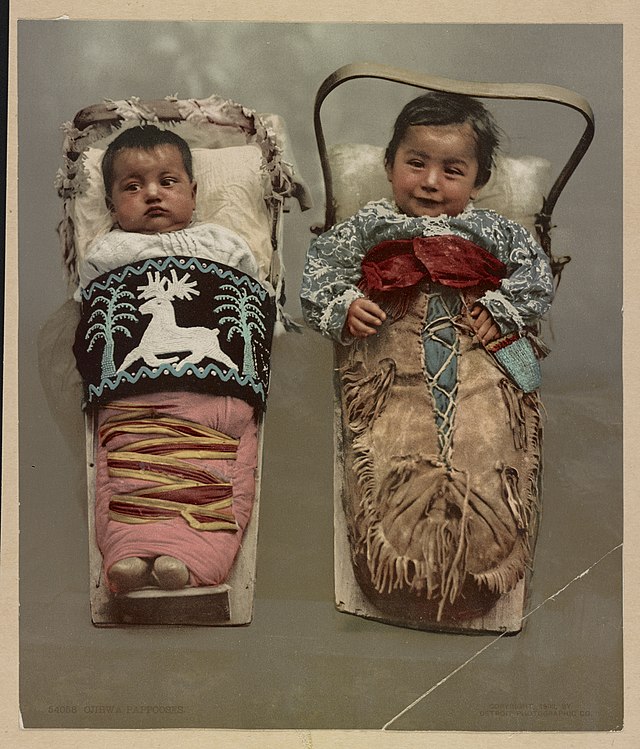It is extremely important that we understand and honor the origins of the parenting tools we utilize as parents so that we do not appropriate cultures.

Humans have always kept their babies close rather than leaving them in a den or home like other mammals. A significant part of human evolution is the increased size of our brains and the skull that covers them. Thus, infant babies developed large heads to make up for our increasingly growing brain size.
This increase in head size meant human babies needed to enter the world prior to when they were developmentally able to cling to their mothers so that they could fit through the birthing person’s birth canal. In order to continue their nomadic lifestyle, early humans began baby wearing to keep their little ones safe and close. This means baby wearing originated from early humans, at least half a million years ago and probably earlier when they began making carriers. Baby carriers may have been one of the first early human inventions!
These carriers may have been constructed from “animal skins, plants, and leather cords to strap babies to the chests of their caregivers—making such carrying devices among the first tools developed, says James McKenna, an anthropology professor at the University of Notre Dame who studies mother-infant relationships.” (Sapien)
Later on, people began to weave fibers together to create cloth. What started as a way to create more secure and longer lasting baby carriers turned into an art form. In asian countries baby carriers were embroidered with beautifully intricate designs. Japanese families would use kimono silk for baby carriers. Similar to how Indian women used Saaris, Mexican women used the sacred Rebozo, and African women used kanga and kitenge fabric.
As a doula, you may hear me speak about or write about the ‘fourth trimester’ and the postpartum period. This is because babies spend nine months in their mother’s uterus and then need several more months attached to their parents in order to develop skills necessary for their lives ‘earth side’. This is where the term ‘Attachment Parenting’ stems from. After Dr. Sears was introduced to indigenous peoples use of baby wearing, it became one of his principles of the ‘Attachment Parenting’ ideology.
“Carriers became the norm for transporting babies, although the materials and designs varied greatly in different times and places. Art from Pharaonic Egypt depicts women with baby carriers, and a 14th-century fresco in a church in Padua, Italy, portrays Mary carrying the baby Jesus in a sling while astride a donkey. But the use of carriers in Western societies fell out of style beginning in Victorian-era Europe when baby carriages became fashionable. As attitudes toward child rearing shifted and parents began to worry about spoiling their children—viewing them more and more as independent beings—mothers chose carriages to create space between themselves and their babies. With the rise of carriages and new parenting attitudes, carriers came to be associated with lower classes and with non-Western cultures.”
Sapien Tweet
In the 1970’s A nurse by the name of Ann Moore created the soft structured carrier, the Snugli, after observing mothers baby wearing in Togo, Africa while working in the peace corps.
The woven wrap company, Didymos, began creating wraps after being introduced to the Mexican Rebozo in 1972.
Since then, several companies such as Ergo, K’tan, Lille bebe, Tula, Didymos, and more have begun to manufacture baby carriers of all different designs and styles. In recent years, the increased use of social media has helped baby wearing flourish in the mainstream parenting world.
Across social media apps, you can find videos showing different woven wrap styles, reviews on brands, contact info on local baby wearing educators, and baby wearing group meet ups. Today, you can purchase wraps, slings, and carriers made from cotton, bamboo, silk, hemp, wool, and more!
It is fascinating to me that as the human race evolved, we were able to create tools to adapt to our world and changing abilities. Baby carriers show how people have adapted to their environments yet kept their littles close. It is also worth recognizing how different European trends have attempted to distance parents from their children in order to distinguish class and to compare those trends to society today.
Modern parents of today have indigenous parents to thank for the continued practice of baby wearing. Had people not rediscovered baby wearing after losing the practice due to Victorian-Era Europe styles, baby carriages, and Eurocentric parenting ideals we wouldn’t have this powerful parenting tool today.


Jenni Jenkins – Sekine is an Oklahoma City Bereavement, Birth, & Postpartum doula and Child Birth Educator who serves her Central Oklahoma community. She is also a midwifery assistant with Holistic Birthing Services and began her journey as a student midwife with the Midwives College of Utah in 2022.
Jenni is also the creator & facilitator of the Kaleidoscope OKC LGBTQ Family Support Group & the Nurture Oklahoma Live Interview Series.
To learn more about Jenni, please click here.